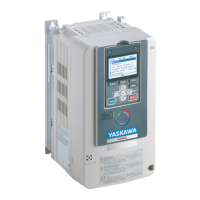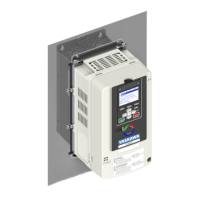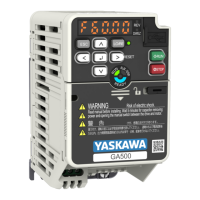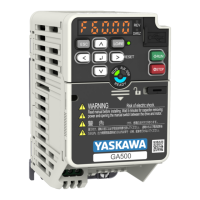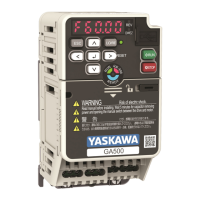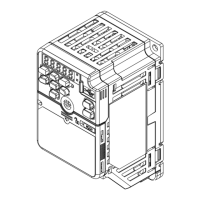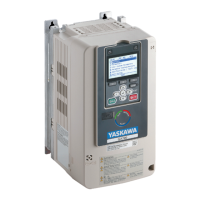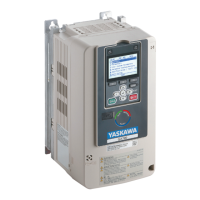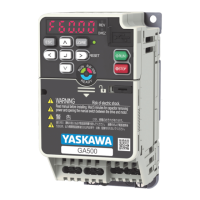6.10 Fine Tuning during Test Runs (Adjust the Control Function)
500 YASKAWA TOEPYAIGA8001B GA800 Drive Maintenance & Troubleshooting
6.10 Fine Tuning during Test Runs (Adjust the Control
Function)
This section gives information about the adjustment procedures to stop hunting or oscillation errors caused by control
function during a test run. Adjust the applicable parameters as specified by your control method and drive status.
• V/f Control and Closed Loop V/f Control on page 500
• Open Loop Vector Control Method on page 501
• Closed Loop Vector Control Method on page 502
• Advanced Open Loop Vector Control Method on page 503
• Open Loop Vector Control for PM Motors on page 504
• Advanced Open Loop Vector Control Method for PM Motors on page 505
• Closed Loop Vector Control Method for PM on page 506
• EZ Open Loop Vector Control Method on page 506
Note:
This section only lists frequently adjusted parameters. If you must adjust parameters that have a higher degree of precision, contact Yaskawa.
◆ V/f Control and Closed Loop V/f Control
Table 6.17 Parameters for Fine Tuning the Drive (V/f and CL-V/f)
Issue Parameter Number Possible Solutions Default Recommended Setting
Hunting or oscillation at mid-range
speeds (10 Hz to 40 Hz)
n1-02 [Hunting Prevention Gain
Setting]
• If torque is not sufficient with
heavy loads, decrease the
setting value.
• If hunting or oscillation occur
with light loads, increase the
setting value.
• If hunting occurs with a low-
inductance motor, for example a
motor with a larger frame size
or a high-frequency motor,
lower the setting value.
1.00 0.10 - 2.00
• The volume of the motor
excitation sound is too high.
• Hunting or oscillation at low
speeds (10 Hz or lower), or at
mid-range speeds (10 Hz to 40
Hz)
C6-02 [Carrier Frequency
Selection]
• If the volume of the motor
excitation sound is too high,
increase the carrier frequency.
• If hunting or oscillation occur at
low or mid-range speeds,
decrease the carrier frequency.
1 (2 kHz)
*1
1 to upper limit value
• Unsatisfactory motor torque
and speed response
• Hunting or oscillation
C4-02 [Torque Compensation
Delay Time]
• If torque or speed response are
slow, decrease the setting value.
• If hunting or oscillation occur,
increase the setting value.
200 ms
*2
100 ms to 1000 ms
• Torque at low speeds (10 Hz or
lower) is not sufficient.
• Hunting or oscillation
C4-01 [Torque Compensation
Gain]
• If torque at low speeds (10 Hz
or lower) is not sufficient,
increase the setting value.
• If hunting or oscillation occur
with light loads, decrease the
setting value.
1.00 0.50 - 1.50
• Torque at low speeds (10 Hz or
lower) is not sufficient.
• Large initial vibration at start
up.
• E1-08 [Mid Point AVoltage]
• E1-10 [Minimum Output
Voltage]
• If torque at low speeds (10 Hz
or lower) is not sufficient,
increase the setting value.
• If there is large initial vibration
at start up, decrease the setting
value
• E1-08: 15.0 V
*3
• E1-10: 9.0 V
*3
Default setting +/- 5 V
*4
Speed precision is unsatisfactory.
(V/f Control)
C3-01 [Slip Compensation Gain]
Set E2-01 [Motor Rated Current],
E2-02 [Motor Rated Slip], and E2-
03 [Motor No-Load Current], then
adjust C3-01.
0.0 (no slip compensation) 0.5 - 1.5
Speed precision is unsatisfactory.
(Closed Loop V/f Control)
• C5-01 [ASR Proportional Gain
1]
• C5-02 [ASR Integral Time 1
(I)]
*5
Adjust C5-01, C5-02.
• C5-01: 0.20
• C5-02: 0.200 s
• Proportional gain = 0.10 to 1.00
• Integral time = 0.100 to 2.000 s
*1 The default setting changes when the settings for C6-01 [Normal / Heavy Duty Selection] and o2-04 [Drive Model (KVA) Selection]
change.
*2 The default setting changes when the settings for A1-02 [Control Method Selection] and o2-04 [Drive Model (KVA) Selection] change.
*3 The default setting changes when the settings for A1-02 [Control Method Selection] and E1-03 [V/f Pattern Selection] change.
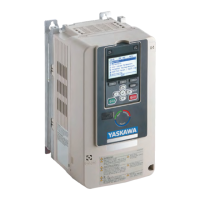
